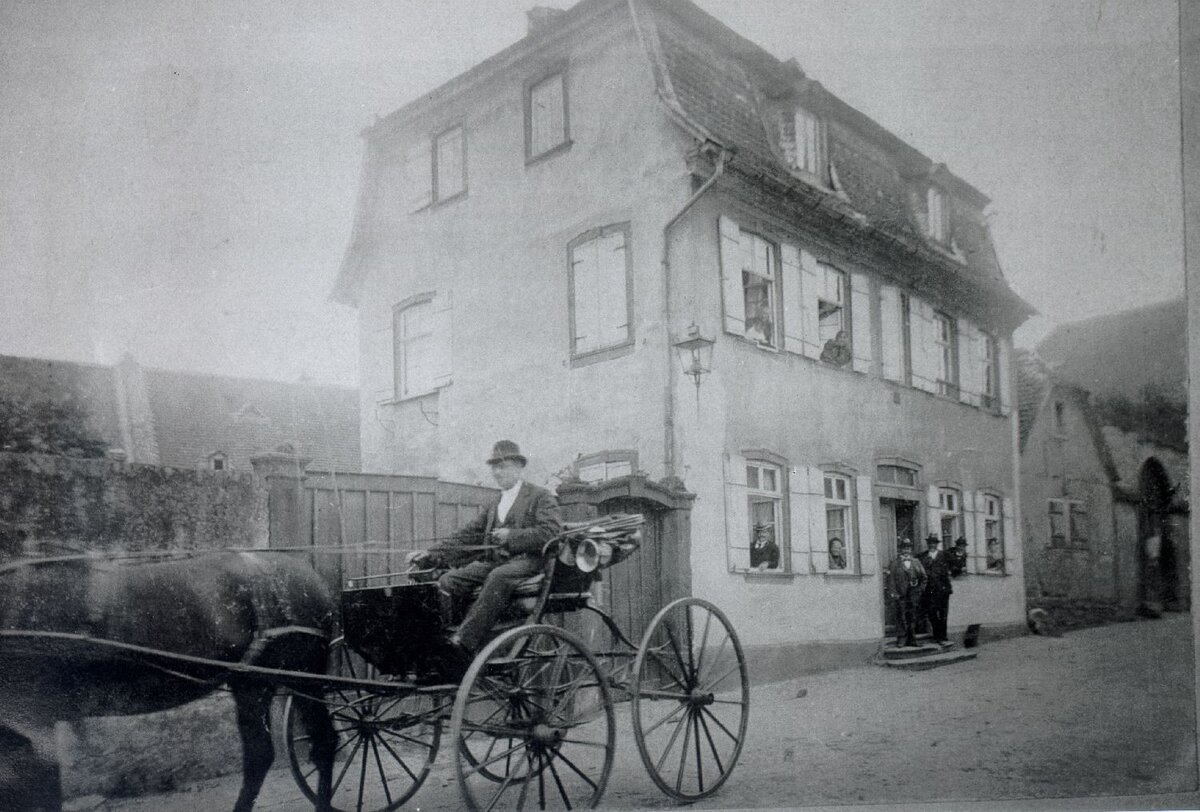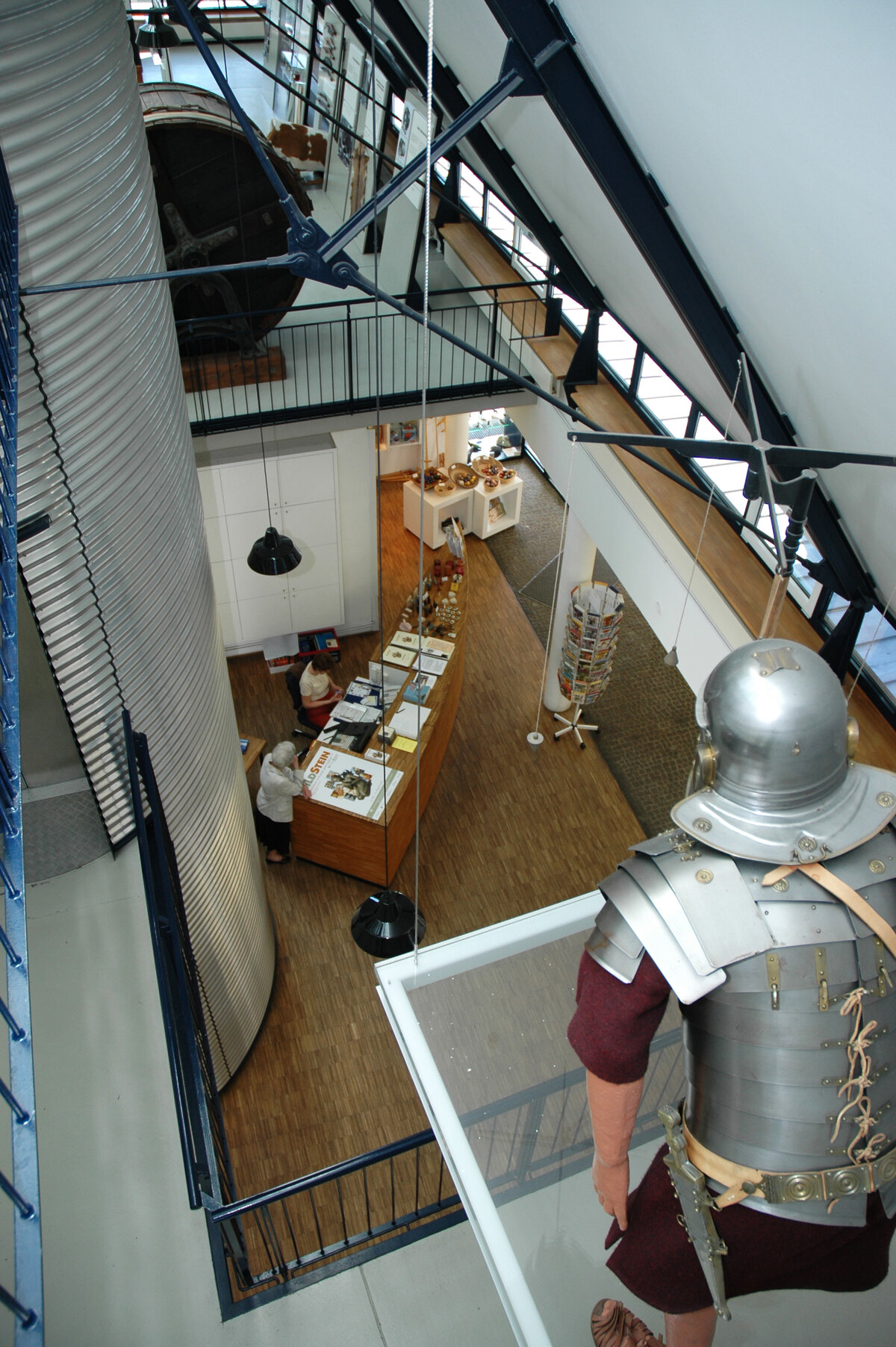Geschichte
The oldest traces discovered to date, which point to the settlement of today's urban area of Hofheim am Taunus, date back to the Palaeolithic period (75,000 BC). Tools from this period were found on the Hochfeld. Even more finds are known from the Neolithic period, from around 5000 BC. A large settlement area from this period has been identified on the banks of the Schwarzbach and on both sides of today's Schmelzweg.
The Michelsberg culture, around 4000 BC, is evidenced by traces of settlement on the Kapellenberg and Hochfeld. Among the finds discovered on the Kapellenberg in particular are axes and hatchets, scrapers, arrowheads, a cult axe and shards of pottery.
Graves from the Early and Middle Bronze Age (1800 BC) were discovered during excavations on the Hochfeld. Again on the Kapellenberg and Hochfeld, finds were made from the Latène period, from 450 BC. This period has also left traces in Langenhain and Diedenbergen. The Romans built a fortified earth camp on the Hochfeld around 40 AD, which was replaced by a stone fort around 75 AD. This fort probably served to protect the Roman road from Mainz via Kastel and Hofheim to Heddernheim. The Romans abandoned the stone fort around 110 AD. After them, the Mattiacs and 150 years later the Alemanni probably settled in today's urban area.
The village of Hofheim was first mentioned in writing in 1254 as "Hoveheim". However, the village was probably founded in Frankish times. This is evidenced, for example, by finds of Frankish graves in the town area. Emperor Charles IV, King of Bohemia with his residence in Prague, signed the document granting Hofheim town rights on March 21, 1352 and had it delivered by a messenger to Count Philip the Elder of Falkenstein. This document gave Philipp the right to build walls, gates and bridges as well as other things to secure the town. A gallows could be erected, which meant that court could be held. From then on, it was also permitted to practise crafts and hold a public market one day a week. Serfdom was abolished.
During the imperial war against Philip the Elder from 1364 to 1366, the Archbishop of Mainz captured the town of Hofheim. However, as it was soon pledged again, the change of ownership initially had no consequences. Construction of the church of St. Peter and Paul began in 1481. The side choir and parts of the tower from this year have been preserved to this day. The church was then completely renovated in 1642. From 1478 to 1559, Hofheim was in the possession of Eppstein-Königstein and, from 1535, Stolberg-Königstein. Under the regency of the Counts of Eppstein-Königstein, the building in which Hofheim's first town hall was later established was built in 1529. The Count of Stolberg-Königstein officially introduced the Reformation in Hofheim in 1540. Archbishop Daniel Brendel von Homburg succeeded, at considerable political and financial expense, in redeeming Hofheim from the Counts of Stolberg in 1559 and definitively in 1565. In 1603, the Electorate of Mainz once again appointed a Catholic priest.
During the Thirty Years' War, Hofheim was plundered and devastated several times by the Spanish, Bavarians, Swedes and French. In 1648, shortly before the war was ended by the Peace of Westphalia, local sovereigns met in the town for secret negotiations.
Out of gratitude for having been spared from the plague, the citizens of Hofheim built a chapel on the Räuberberg (now Kapellenberg) in 1667 in honor of the Holy Mother of God and vowed to go there once a year to do penance. In 1772, the half-timbered building was demolished and replaced by a larger stone chapel.
You can find more information about the Hofheim mountain chapel at Hofheim am Taunus: Things to see in Hofheim " (fcio.net).
Until 1819, the moated castle ("old castle") and winery buildings in the old town area formed the so-called manorial winery courtyard and were separated from the town by walls and gates. An examination of the building fabric of the moated castle revealed a date of origin around 1354/55 (dendrochronological examination). A wine press house from the 17th century can still be found within the walls. Parts of the cellar building - a historical administrative office for taxes in kind - could be traced back to 1425/26 (C14 method, dendrochronological examination). The predecessor building was originally built and used as a stable.
After the Thirty Years' War, both the moated castle and the stables were in a ruinous state. The latter was later extended and converted into the Herrenscheuer, complete with granary and parlors. From 1717 to 1719, the Elector and Archbishop of Mainz, Lothar Franz von Schönborn, had the cellar building extended and had private rooms built for himself on the upper floor. This gave it its late Baroque façade, which still exists today.
As a result of the French Revolution, the moated castle and winery building were occupied and destroyed. In 1876, they were purchased by the city and changed their use several times. In 1975, the winery building was handed over to the Hofheim clubs for use. In 2010, a two-year, fundamental renovation was completed.
In 1803, Hofheim passed from Electorate Mainz to the Princes of Nassau-Usingen, later Dukes of Nassau, as a result of the Reichsdeputationshauptschluss. In 1866, the Duchy of Nassau was annexed to Prussia. Hofheim belonged to the Main district from 1867 and to the Höchst district from 1886. This period saw the construction of the Frankfurt-Hofheim-Limburg railroad line (1874 to 1877), which also brought Hofheim an economic upturn. In 1895, the Verkehrs- und Verschönerungsverein built a wooden observation tower on the Kapellenberg. At the beginning of this century (1902), a water pipe was laid in Hofheim, and in October 1908, electric light was switched on for the first time. During these six years, the population grew from 2800 to 4040 inhabitants. In 1920, Hofheim was awarded the town coat of arms, which has been valid ever since. Hofheim has been supplied with gas since 1925. Three years later, the observation tower on the Kapellenberg was replaced by a steel structure, which was given the name Meisterturm. The tower was named after the first district administrator of the Höchst district, Dr. Wilhelm von Meister. Marxheim was incorporated in 1938.
On the night of November 9-10, 1938, the entire interior of the prayer house (synagogue) of the Jewish community in Hofheim was destroyed and the building, a former town tower, was damaged. In 1933, the Jewish community had 33 members; by 1942, there were no more Jewish residents in Hofheim. Only a few managed to flee abroad, most were murdered by the National Socialists.
In 1972, the previously independent municipalities of Diedenbergen, Langenhain and Lorsbach became part of Hofheim. In 1977, the town of Hofheim gained two more new districts, Wallau and Wildsachsen. In the same year, the 625th anniversary was celebrated with a cultural week. Hofheim has been the district town of the Main-Taunus district since January 1, 1980. The seat of the district administration was moved from Höchst to Hochfeld in Hofheim in 1987. One year later, Hofheim was the city of the Hessentag. The district town was awarded the flag of honor of the Council of Europe in 1991. The twin towns of Hofheim am Taunus have been Chinon (France) since 1967, Tiverton (England) since 1980, Buccino (Italy) since 2008 and Pruszcz Gdański (Poland) since 2012.
Hofheim has been a Fairtrade city since 2011.



